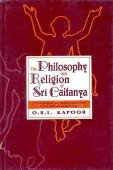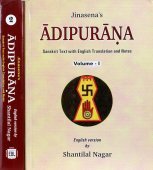Gosvami, Gosvāmī: 4 definitions
Introduction:
Gosvami means something in Hinduism, Sanskrit, Marathi. If you want to know the exact meaning, history, etymology or English translation of this term then check out the descriptions on this page. Add your comment or reference to a book if you want to contribute to this summary article.
In Hinduism
Vaishnavism (Vaishava dharma)
Source: ISKCON Press: GlossaryGosvāmī (गोस्वामी).—A person who has his senses under full control: the title of a person in the renounced order of life, sannyasa. (go-senses + svamī-master) master of the senses.
Source: Pure Bhakti: Bhagavad-gita (4th edition)Gosvāmī (गोस्वामी) refers to “(1) One who is the master of one’s senses, detached from material elements (2) One in the renounced order of life”. (cf. Glossary page from Śrīmad-Bhagavad-Gītā).

Vaishnava (वैष्णव, vaiṣṇava) or vaishnavism (vaiṣṇavism) represents a tradition of Hinduism worshipping Vishnu as the supreme Lord. Similar to the Shaktism and Shaivism traditions, Vaishnavism also developed as an individual movement, famous for its exposition of the dashavatara (‘ten avatars of Vishnu’).
Languages of India and abroad
Marathi-English dictionary
Source: DDSA: The Molesworth Marathi and English Dictionarygōsvāmī (गोस्वामी).—m S One who has his passions under subjection. See the popular form gōsāvī.
Marathi is an Indo-European language having over 70 million native speakers people in (predominantly) Maharashtra India. Marathi, like many other Indo-Aryan languages, evolved from early forms of Prakrit, which itself is a subset of Sanskrit, one of the most ancient languages of the world.
Kannada-English dictionary
Source: Alar: Kannada-English corpusGōsvāmi (ಗೋಸ್ವಾಮಿ):—
1) [noun] the master or possessor of a cow or cows.
2) [noun] a man who has subdued his worldly passions; a religious or yogic mendicant.
Kannada is a Dravidian language (as opposed to the Indo-European language family) mainly spoken in the southwestern region of India.
See also (Relevant definitions)
Starts with: Gosvamin, Gosvaminam gunaleshavarnanam, Gosvamisthana.
Ends with: Carmagosvami, Rupagosvami, Sanatanagosvami, Shivagosvami, Sutagosvami.
Full-text (+37): Haribhaktivilasa, Sanatanagosvami, Shaunaka, Parikshit, Cuta, Shyamasundara, Radhakrishna, Upadeshamrita, Rupanugabhakta, Bhagavatamritam, Digdarshini, Ujjvalanilamani, Kilakincita, Bhaktirasamritasindhu, Amra, Badarayana, Gitagovinda, Nipa, Veda, Parashurama.
Relevant text
Search found 24 books and stories containing Gosvami, Gosvāmī, Gōsvāmī, Gōsvāmi; (plurals include: Gosvamis, Gosvāmīs, Gōsvāmīs, Gōsvāmis). You can also click to the full overview containing English textual excerpts. Below are direct links for the most relevant articles:
Chaitanya Bhagavata (by Bhumipati Dāsa)
Verse 2.19.49 < [Chapter 19 - The Lord’s Pastimes in Advaita’s House]
Verse 3.2.208 < [Chapter 2 - Description of the Lord’s Travel Through Bhuvaneśvara and Other Placesto Jagannātha Purī]
Verse 1.1.2 < [Chapter 1 - Summary of Lord Gaura’s Pastimes]
Srila Gurudeva (The Supreme Treasure) (by Swami Bhaktivedanta Madhava Maharaja)
At Śrī Rādhā-Dāmodara Mandīra < [Chapter 2.7 - Śrīla Gurudeva and Śrīla Bhaktivedānta Swāmī Mahārāja]
Rāga-vartma-candrika < [Chapter 2.12 - Early ISKCON Conversations with Śrīla Gurudeva]
Representative Heads West < [Chapter 2.17 - Beginning of Śrīla Gurudeva's Preaching in the West]
Sahitya-kaumudi by Baladeva Vidyabhushana (by Gaurapada Dāsa)
The Bible of Sanskrit Poetics < [Introduction]
Text 2.38 < [Chapter 2 - The Natures of Words (śabda)]
Text 11.53 < [Chapter 11 - Additional Ornaments]
Brihad Bhagavatamrita (commentary) (by Śrī Śrīmad Bhaktivedānta Nārāyana Gosvāmī Mahārāja)
Bhajana-Rahasya (by Srila Bhaktivinoda Thakura Mahasaya)
Text 4 < [Chapter 8 - Aṣṭama-yāma-sādhana (Rātri-līlā–prema-bhajana sambhoga)]
Text 11 < [Chapter 5 - Pañcama-yāma-sādhana (Aparāhna-kālīya-bhajana–kṛṣṇa-āsakti)]
Text 44 < [Chapter 2 - Dvitīya-yāma-sādhana (Prātaḥ-kālīya-bhajana)]
Shrimad Bhagavad-gita (by Narayana Gosvami)
Distinguished Service to the Gauḍīya Vaiṣṇava Sampradāya < [Introduction (to the Hindi edition)]
Related products




